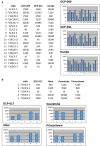Leptospira borgpetersenii serovar Hardjo and Leptospira santarosai serogroup Pyrogenes isolated from bovine dairy herds in Puerto Rico
- PMID: 36467637
- PMCID: PMC9712998
- DOI: 10.3389/fvets.2022.1025282
Leptospira borgpetersenii serovar Hardjo and Leptospira santarosai serogroup Pyrogenes isolated from bovine dairy herds in Puerto Rico
Abstract
Leptospirosis is one of the most common zoonotic diseases in the world and endemic in the Caribbean Islands. Bovine leptospirosis is an important reproductive disease. Globally, cattle are recognized as a reservoir host for L. borgpetersenii serovar Hardjo, which is transmitted via urine, semen, and uterine discharges, and can result in abortion and poor reproductive performance. The dairy industry in Puerto Rico comprises up to 25% of agriculture-related income and is historically the most financially important agricultural commodity on the island. In this study, we report the isolation of two different pathogenic Leptospira species, from two different serogroups, from urine samples collected from dairy cows in Puerto Rico: L. borgpetersenii serogroup Sejroe serovar Hardjo and L. santarosai serogroup Pyrogenes. Recovered isolates were classified using whole-genome sequencing, serotyping with reference antisera and monoclonal antibodies, and immunoblotting. These results demonstrate that dairy herds in Puerto Rico can be concurrently infected with more than one species and serovar of Leptospira, and that bacterin vaccines and serologic diagnostics should account for this when applying intervention and diagnostic strategies.
Keywords: Leptospira; Puerto Rico; borgpetersenii; cow; dairy; leptospirosis; santarosai.
Copyright © 2022 Hamond, Dirsmith, LeCount, Soltero, Rivera-Garcia, Camp, Anderson, Hicks, Galloway, Sutherland, Schafer, Goris, van der Linden, Stuber, Bayles, Schlater and Nally.
Conflict of interest statement
The authors declare that the research was conducted in the absence of any commercial or financial relationships that could be construed as a potential conflict of interest.
Figures



Similar articles
-
Bovine Leptospirosis Due to Persistent Renal Carriage of Leptospira borgpetersenii Serovar Tarassovi.Front Vet Sci. 2022 Apr 5;9:848664. doi: 10.3389/fvets.2022.848664. eCollection 2022. Front Vet Sci. 2022. PMID: 35464389 Free PMC article.
-
Isolation of pathogenic Leptospira strains from naturally infected cattle in Uruguay reveals high serovar diversity, and uncovers a relevant risk for human leptospirosis.PLoS Negl Trop Dis. 2018 Sep 13;12(9):e0006694. doi: 10.1371/journal.pntd.0006694. eCollection 2018 Sep. PLoS Negl Trop Dis. 2018. PMID: 30212451 Free PMC article.
-
Isolation and molecular characterization of Leptospira borgpetersenii serovar Hardjo strain Hardjobovis in the urine of naturally infected cattle in Brazil.Genet Mol Res. 2016 Feb 19;15(1). doi: 10.4238/gmr.15018473. Genet Mol Res. 2016. PMID: 26909976
-
A cluster of three cases of leptospirosis in dairy farm workers in New Zealand.N Z Med J. 2014 Jan 24;127(1388):13-20. N Z Med J. 2014. PMID: 24481382 Review.
-
Aseptic meningitis as the initial presentation of Leptospira borgpetersenii serovar Tarassovi: two case reports and a literature review.BMC Infect Dis. 2021 May 27;21(1):488. doi: 10.1186/s12879-021-06200-w. BMC Infect Dis. 2021. PMID: 34044779 Free PMC article. Review.
Cited by
-
Identification of equine mares as reservoir hosts for pathogenic species of Leptospira.Front Vet Sci. 2024 May 9;11:1346713. doi: 10.3389/fvets.2024.1346713. eCollection 2024. Front Vet Sci. 2024. PMID: 38784659 Free PMC article.
-
DNA Capture and Enrichment: A Culture-Independent Approach for Characterizing the Genomic Diversity of Pathogenic Leptospira Species.Microorganisms. 2023 May 14;11(5):1282. doi: 10.3390/microorganisms11051282. Microorganisms. 2023. PMID: 37317256 Free PMC article.
-
Leptospira borgptersenii and Leptospira interrogans identified in wild mammals in Rio Grande do Sul, Brazil.Braz J Microbiol. 2024 Jun;55(2):1941-1948. doi: 10.1007/s42770-024-01348-4. Epub 2024 Apr 30. Braz J Microbiol. 2024. PMID: 38691328 Free PMC article.
-
Isolation of Leptospira kirschneri serovar Grippotyphosa from a red panda (Ailurus fulgens) after antimicrobial therapy: Case report.Front Vet Sci. 2023 Feb 2;9:1064147. doi: 10.3389/fvets.2022.1064147. eCollection 2022. Front Vet Sci. 2023. PMID: 36819120 Free PMC article.
-
Host population dynamics influence Leptospira spp. transmission patterns among Rattus norvegicus in Boston, Massachusetts, US.PLoS Negl Trop Dis. 2025 Apr 15;19(4):e0012966. doi: 10.1371/journal.pntd.0012966. eCollection 2025 Apr. PLoS Negl Trop Dis. 2025. PMID: 40233129 Free PMC article.
References
LinkOut - more resources
Full Text Sources

